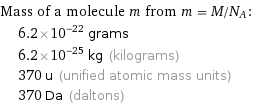Input interpretation
![diazene, bis[4-(pentyloxy)phenyl]-, 1-oxide | molar mass](../image_source/d637bde30b3443a32f9cd35cc32c55bd.png)
diazene, bis[4-(pentyloxy)phenyl]-, 1-oxide | molar mass
Result
![Find the molar mass, M, for diazene, bis[4-(pentyloxy)phenyl]-, 1-oxide: M = sum _iN_im_i Plan: • Write the chemical formula and gather atomic masses from the periodic table. • Determine values for N_i and m_i using these items. • Finally, compute the mass. Write the chemical formula: C_22H_30N_2O_3 Use the chemical formula to count the number of atoms, N_i, for each element: | N_i C (carbon) | 22 H (hydrogen) | 30 N (nitrogen) | 2 O (oxygen) | 3 Look up the atomic mass, m_i, in g·mol^(-1) for each element in the periodic table: | N_i | m_i/g·mol^(-1) C (carbon) | 22 | 12.011 H (hydrogen) | 30 | 1.008 N (nitrogen) | 2 | 14.007 O (oxygen) | 3 | 15.999 Multiply N_i by m_i to compute the mass for each element. Then sum those values to compute the molar mass, M: Answer: | | | N_i | m_i/g·mol^(-1) | mass/g·mol^(-1) C (carbon) | 22 | 12.011 | 22 × 12.011 = 264.242 H (hydrogen) | 30 | 1.008 | 30 × 1.008 = 30.240 N (nitrogen) | 2 | 14.007 | 2 × 14.007 = 28.014 O (oxygen) | 3 | 15.999 | 3 × 15.999 = 47.997 M = 264.242 g/mol + 30.240 g/mol + 28.014 g/mol + 47.997 g/mol = 370.493 g/mol](../image_source/204bf342e1426d23269aa34d3fbeb242.png)
Find the molar mass, M, for diazene, bis[4-(pentyloxy)phenyl]-, 1-oxide: M = sum _iN_im_i Plan: • Write the chemical formula and gather atomic masses from the periodic table. • Determine values for N_i and m_i using these items. • Finally, compute the mass. Write the chemical formula: C_22H_30N_2O_3 Use the chemical formula to count the number of atoms, N_i, for each element: | N_i C (carbon) | 22 H (hydrogen) | 30 N (nitrogen) | 2 O (oxygen) | 3 Look up the atomic mass, m_i, in g·mol^(-1) for each element in the periodic table: | N_i | m_i/g·mol^(-1) C (carbon) | 22 | 12.011 H (hydrogen) | 30 | 1.008 N (nitrogen) | 2 | 14.007 O (oxygen) | 3 | 15.999 Multiply N_i by m_i to compute the mass for each element. Then sum those values to compute the molar mass, M: Answer: | | | N_i | m_i/g·mol^(-1) | mass/g·mol^(-1) C (carbon) | 22 | 12.011 | 22 × 12.011 = 264.242 H (hydrogen) | 30 | 1.008 | 30 × 1.008 = 30.240 N (nitrogen) | 2 | 14.007 | 2 × 14.007 = 28.014 O (oxygen) | 3 | 15.999 | 3 × 15.999 = 47.997 M = 264.242 g/mol + 30.240 g/mol + 28.014 g/mol + 47.997 g/mol = 370.493 g/mol
Unit conversion

0.37049 kg/mol (kilograms per mole)
Comparisons

≈ 0.51 × molar mass of fullerene ( ≈ 721 g/mol )

≈ 1.9 × molar mass of caffeine ( ≈ 194 g/mol )

≈ 6.3 × molar mass of sodium chloride ( ≈ 58 g/mol )
Corresponding quantities

Mass of a molecule m from m = M/N_A: | 6.2×10^-22 grams | 6.2×10^-25 kg (kilograms) | 370 u (unified atomic mass units) | 370 Da (daltons)

Relative molecular mass M_r from M_r = M_u/M: | 370